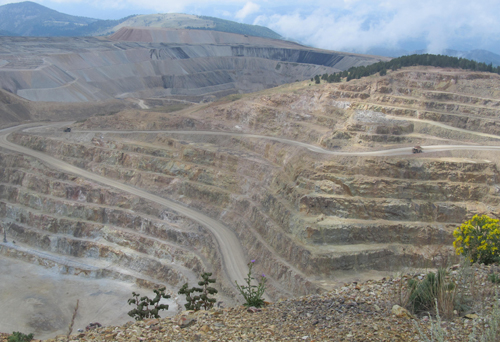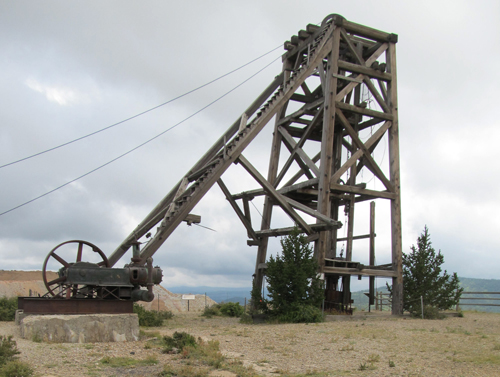Thursday, July 03 2014
Victor, Colorado -- the City of Mines Victor is a small quaint mountain town now, but back in the late 1890s, more than 8,000 lived and worked here. By the time the town was platted in 1893, it was already known as the City of Mines because the largest and richest gold mines of the Cripple Creek and Victor District were located on Battle Mountain just above town. Today, several headframes still jut into the sky, and brick buildings dating to 1899 still line the streets. Between 1899 and 1902, booming Victor boasted 48 saloons, 29 doctors, 15 restaurants, 12 banks, eight pharmacies, six churches, five architects, two newspapers and more. In early 1899, a fire destroyed the original false-front pine buildings and left 3,000 people homeless. Within six months, though, the businesses were rebuilt in brick or stone. Just like in Cripple Creek, Victor saw its share of the Colorado Labor Wars, too. The Western Federation of Miners union hall on 4th Street has some telltale bullet holes to prove it! Interpretive signs posted at intersections around Victor relate colorful stories about the Red Light Social Clubs, the famous girls who entertained at the Fortune Club, and about the town’s founders. Take a walk and envision the streets as they would have been over 100 years ago. If you need a little help imagining yesteryear, the photographs in the Lowell Thomas Museum depict life in early Victor, and it is also the best place to learn about the town’s pioneers. The museum’s namesake is none other than the internationally renowned radio news broadcaster, author, and film producer Lowell Thomas. Between 1930 and 1976, Mr. Thomas’s 15-minute nightly news and commentary aired just before the famous Amos ‘n Andy Show, and had a audience numbering more than that of the NBC, CBS and ABC TV news anchors combined. Victor was Lowell Thomas’s boyhood home. American Eagles Scenic Overlook
In 1895, the American Eagles Mine at this site was the highest underground mine in the district. This mine had three shafts, the deepest had reached 1,540 feet by 1902. Shafts are vertical excavations through which miners and supplies are taken into and out of underground workings. Headframes sit above the vertical shaft in order to support the sheave wheel or pulley system that passed the hoist cable from the steam or electric-powered hoisting mechanism to the metal cage that hauled men and supplies. Tunnels on the other hand, are horizontal excavations, driven from the surface into the side of a hill to connect with the underground workings some distance away. Technically speaking, tunnels have surface openings on both ends. A one-opening tunnel is an adit.
On your drive up to the American Eagles Scenic Overlook, expect to stop at a checkpoint and give your name to a Cripple Creek and Victor Gold Mining Company employee. Your visit is welcomed, so the checkpoint is for nothing other than your safety. You’ll be told if it is OK to proceed (the road is closed during blasting), and will be cautioned about the giant haul trucks that share part of the same road. Access the American Eagles Scenic Overlook north of Victor at the intersection of County Roads 81 and 83 on Bull Hill Pass. The route is signed. Trails of GoldThe remains of many mining operations pepper the landscape in and around Victor. Quite a few sites are connected by hiking trails (pick up a map at the visitor center in Victor). These “Trails of Gold” offer up-close looks at more relics of yesteryear as well as active mining activities. The trails include good signage about the area history. Some buildings are heaps of rubble, some are still standing— it all depends on Mother Nature. Be careful when exploring these sites, and if you’re normally a flatlander, remember that you’re trekking at elevations of 9,500-10,500 feet above sea level.
Cripple Creek and Victor continue to pay tribute to their 1890s heritage as The World’s Greatest Gold Camp. In and around these tiny towns, much of the area’s gold rush history has been preserved and continues to be a source of pride for the Centennial State (the nickname comes from Colorado becoming the 38th state, 100 years after the signing of the Declaration of Independence). Whether you want to tour gold mines, participate in year-round special events, visit museums, or just marvel at the historic headframes and other vestiges of mining equipment backdropped by mountain views, there’s a wealth of activities and sites to keep you interested and entertained. This photofeature by Denise Seith also appears in the May/June 2014 issue of Gold Prospector Magazine, published by the Gold Prospectors Association of America. Comments:
|






 A few miles outside of Victor, you’ll find an impressive view of the Cripple Creek and Victor Mining District from atop the American Eagles Scenic Overlook. Stop at the Victor visitor center first (formerly a train depot) for a map. From an elevation of 10,570 feet, you get a bird’s eye look down into the CC&V surface operations where massive 240-ton haul trucks riding on 12-foot diameter tires haul ore up and down a abyrinth of roads. Mount Pisgah and the Sangre de Cristo and Collegiate Mountains make a nice backdrop.
A few miles outside of Victor, you’ll find an impressive view of the Cripple Creek and Victor Mining District from atop the American Eagles Scenic Overlook. Stop at the Victor visitor center first (formerly a train depot) for a map. From an elevation of 10,570 feet, you get a bird’s eye look down into the CC&V surface operations where massive 240-ton haul trucks riding on 12-foot diameter tires haul ore up and down a abyrinth of roads. Mount Pisgah and the Sangre de Cristo and Collegiate Mountains make a nice backdrop.  The original American Eagles headframe is still standing proudly, and the double-drum hoist is still in its place, too. The shaft, however, has been sealed. Remnants of a blacksmith shop and mine superintendent’s house are also at the overlook. Interpretive signs around the site tell the story of Winfield Stratton who purchased the American Eagles in 1895 after a huge success with his local Independence Mine. In fact, Mr. Stratton was Victor’s first millionaire and sold the Independence Mine for $11 million. The American Eagles was worked until 1940, but unfortunately little is known about its actual production since it was a private claim.
The original American Eagles headframe is still standing proudly, and the double-drum hoist is still in its place, too. The shaft, however, has been sealed. Remnants of a blacksmith shop and mine superintendent’s house are also at the overlook. Interpretive signs around the site tell the story of Winfield Stratton who purchased the American Eagles in 1895 after a huge success with his local Independence Mine. In fact, Mr. Stratton was Victor’s first millionaire and sold the Independence Mine for $11 million. The American Eagles was worked until 1940, but unfortunately little is known about its actual production since it was a private claim. The Independence Town Site is an interesting stop. The steel headframe of the Vindicator Mine is hard to miss, and a gravel path takes you past what’s left of a surface plant, ore processing facility, and a residence that has definitely seen better days. Independence originated as Hull’s Camp on the Hull City placer claim. Although some placer gold was found, the real riches came from underground veins, so there were several different mines here. The Vindicator is credited with producing a total of 1,244,000 troy ounces of gold between 1895 and 1953. Also nearby is what remains of the Theresa Mine, which produced over 120,000 troy ounces between 1895 and 1961.
The Independence Town Site is an interesting stop. The steel headframe of the Vindicator Mine is hard to miss, and a gravel path takes you past what’s left of a surface plant, ore processing facility, and a residence that has definitely seen better days. Independence originated as Hull’s Camp on the Hull City placer claim. Although some placer gold was found, the real riches came from underground veins, so there were several different mines here. The Vindicator is credited with producing a total of 1,244,000 troy ounces of gold between 1895 and 1953. Also nearby is what remains of the Theresa Mine, which produced over 120,000 troy ounces between 1895 and 1961.